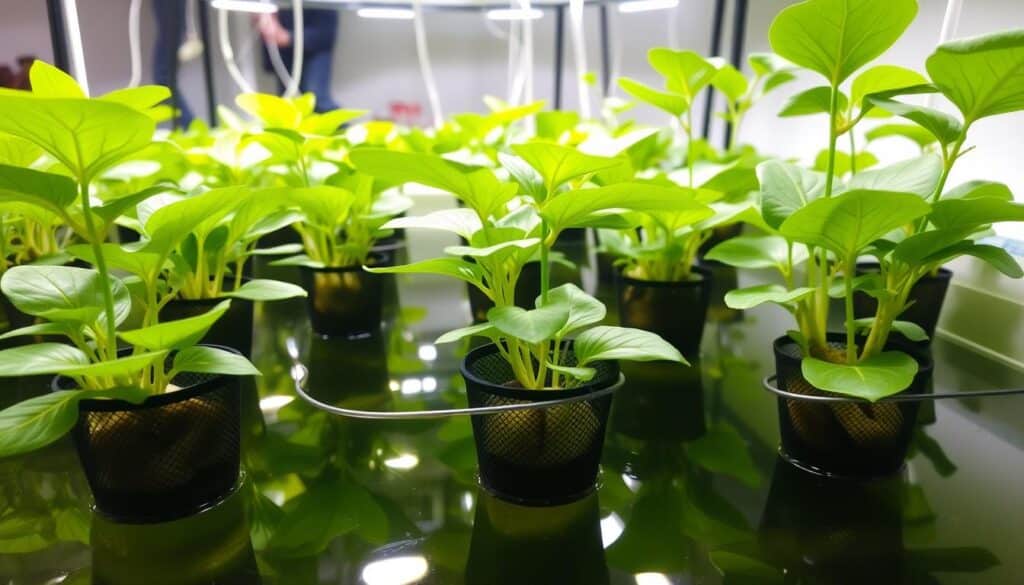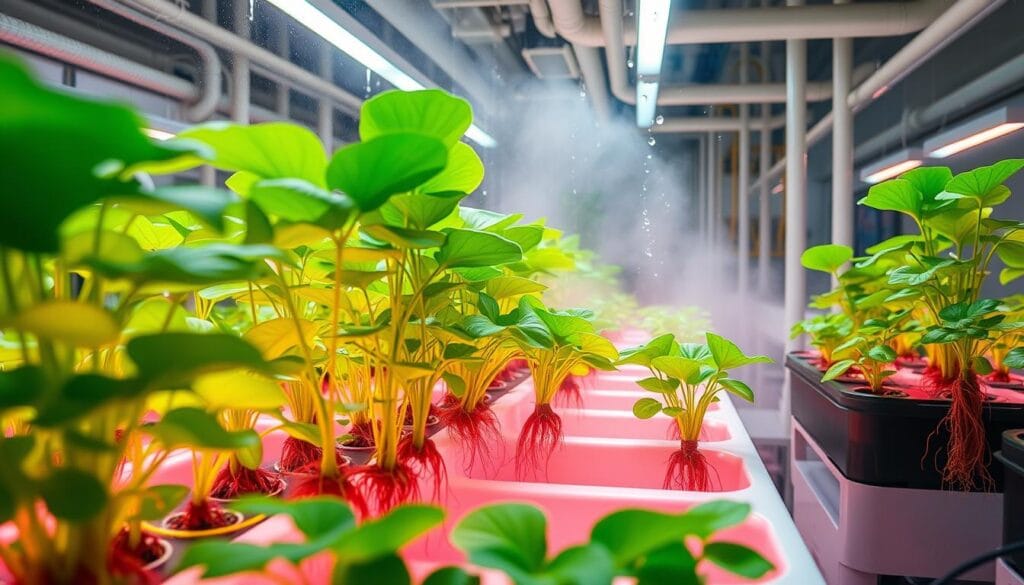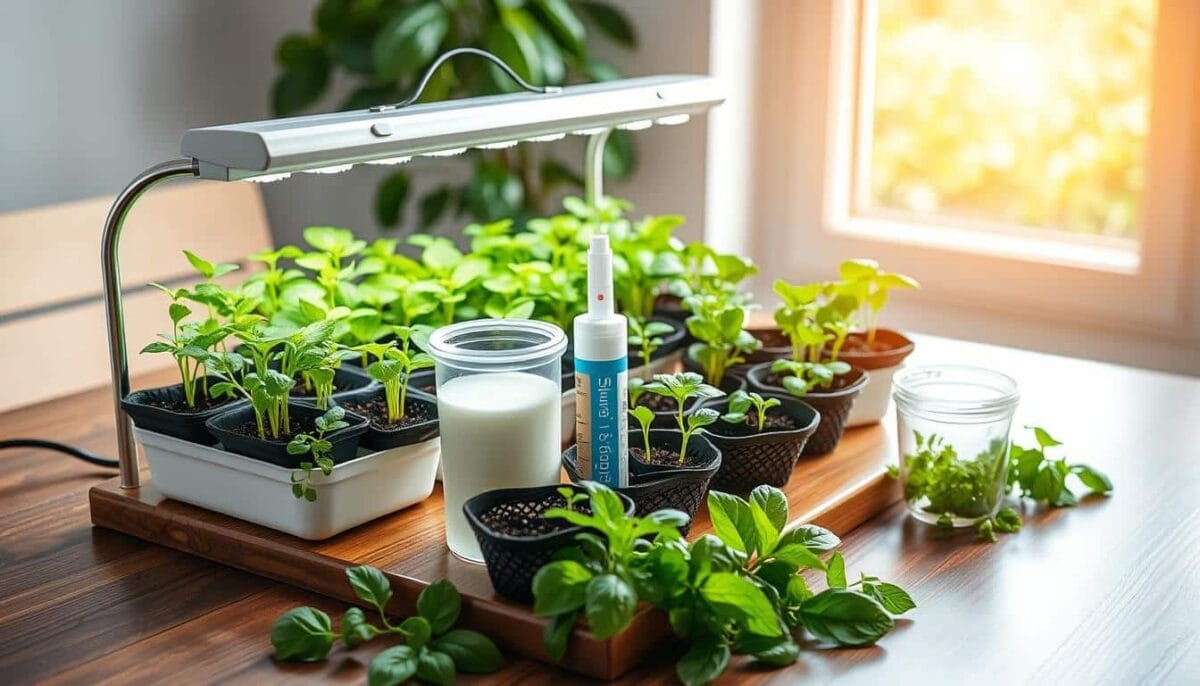Starting an indoor garden is exciting and rewarding, especially with hydroponics. Hydroponics grow plants without soil, using water solutions with nutrients. This method is popular, with a global market value of USD 4.65 billion in 2022.
For beginners, picking the right hydroponic starter kit is key for a good growing experience. These kits have everything you need, from seeds to pH adjusters. They’re perfect for growing herbs, vegetables, or hydroponic cannabis grow kits.
In this guide, we’ll look at the best hydroponic starter kit options. We’ll cover Deep Water Culture (DWC), Nutrient Film Technique (NFT), and Aeroponic systems. This will help you choose the right indoor hydroponic kit for your needs and space.
Key Takeaways
- Hydroponic systems offer many benefits, like faster plant growth and year-round harvesting. They’re also good for the environment.
- Choosing the right hydroponic starter kit is important for beginners. It affects ease of use, size, cost, and versatility.
- Indoor hydroponic kit options like DWC, NFT, and Aeroponic systems meet different needs. They vary in complexity and maintenance.
- When picking a complete indoor hydroponic grow system, consider ease of use, customization, customer support, price, and value.
- Beginners should look for hydroponic cannabis grow kits and all-in-one systems. They should include seeds, nutrients, and test kits to make setup and maintenance easier.
Introduction to Hydroponics
Growing plants without soil is now possible through hydroponic methods. It uses water full of nutrients to feed plant roots. This method helps plants grow fast and strong, making it great for growing many types of plants.
What is Hydroponics?
Hydroponics means growing plants without soil. It’s a method that lets plants grow faster and better. Hydroponic systems give plants the nutrients they need right at their roots.
Benefits of Hydroponic Gardening
- Enhanced control over the growing environment
- Increased resource efficiency and sustainability
- Minimal space requirements, allowing for vertical growing
- Year-round growing potential, even in harsh or compromised climates
- Production of clean, nutritious food with an extended shelf life
Hydroponic systems provide many benefits that surpass soil gardening. It lets you control the growing space better. It also saves water and nutrients, making it good for the planet.
“Hydroponics is the future of agriculture, allowing us to grow more with less and create a sustainable food supply for generations to come.”
Hydroponics is exciting for both new and experienced gardeners. It opens up new ways to grow plants. By learning about hydroponics, you can discover its many benefits of hydroponic gardening.
Considerations for Choosing a Hydroponic Starter Kit
When picking a hydroponic starter kit, think about a few important things. These include how easy it is to use, how much space it needs, and how much it costs. These factors can really help you succeed in hydroponic gardening.
Ease of Use
The user-friendly nature of a hydroponic starter kit is key for beginners. Look for beginner-friendly hydroponic kits that are easy to set up and use. They should come with clear instructions and not have too many parts. Features like timers and systems for adding nutrients can make it even easier to start.
Size and Space Requirements
The space you have will also play a big role in choosing a hydroponic starter kit. Compact hydroponic systems and vertical hydroponic gardens are great for those with little room. They use space well and don’t take up much room.
Cost and Affordability
For beginners, it’s smart not to spend too much on the first system. Look for budget-friendly hydroponic kits that are affordable but still work well. Kits that include everything you need can save you time and money, making them a good choice for beginners.
“The secret to effective hydroponic gardening lies in finding the ideal mix of cost, functionality, and simplicity”
Top Hydroponic Starter Kit Options
The market has many hydroponic starter kits for beginners. Each kit has its own features and benefits. You can find everything from the Aerogarden to the Gardyn system, fitting all levels of gardening skills.
The Aerogarden offers models like the Farm 12XL and Farm 24XL. These can grow 12 or 24 plants indoors, just like outdoor gardening. The Click & Grow Smart Garden is smaller, perfect for herbs but not as big for veggies.
The Gardyn system is great for a bigger setup. This system can support up to 30 plants at one time. You can grow many types of food, including lettuce, herbs, and even tomatoes. Plus, its pods are biodegradable, making it eco-friendly.
| Starter Kit | Capacity | Maintenance | Key Features |
|---|---|---|---|
| Aerogarden | 3-24 pods | Low | Self-contained, synthetic fertilizer (NPK 4-3-6) |
| Click & Grow Smart Garden | 27 pods | Medium | Compact, suitable for herbs |
| Gardyn | 30 plants | Medium | Versatile, eco-friendly pods, monthly subscription |
These are just a few of the many hydroponic starter kits out there. Each one meets different needs and budgets. It’s important to pick the right one for your hydroponic gardening journey.
Deep Water Culture (DWC) Systems
If you’re new to hydroponic gardening, deep water culture (DWC) systems are great for you. They are simple and affordable. Plants grow fast in a nutrient-rich water solution. DWC systems need air pumps to keep the roots oxygenated.
How DWC Systems Work
DWC systems soak plant roots in a nutrient-rich water. An air pump adds oxygen. This helps plants grow fast and strong. DWC systems are easy to start with because they control the environment and nutrients well.
Advantages of DWC for Beginners
- Simple and straightforward setup
- Efficient nutrient delivery for rapid plant growth
- Consistent water and nutrient levels for hassle-free maintenance
- Beginner-friendly due to the ease of use and hands-off approach
- Compact design that fits well in small spaces
- Cost-effective option for those new to hydroponic gardening
DWC hydroponic systems are perfect for beginners. They are easy to use and help plants grow well. The benefits of DWC hydroponic systems make them a great choice for why choose DWC for beginners.

Nutrient Film Technique (NFT) Systems
The Nutrient Film Technique (NFT) system is great for beginners. It’s simple and efficient. Plants get a constant flow of nutrients from a thin film of water. It’s perfect for growing small plants and herbs indoors.
NFT systems need a slope of 1:30 to 1:40. This helps water move well and keeps air flowing. You’ll need to adjust the water flow based on plant size and growth. Channels can be a few feet to 40 feet long, needing more feed lines for longer ones.
NFT systems save on growing media and improve nutrient uptake. They also save water and offer good aeration. But, they’re more expensive to start, need a specific slope, and have moving parts to maintain.
To set up an NFT system, you’ll need channels, net cups, a reservoir, a pump, and air pumps (if needed). The SuperCloner 14-Site Hydroponic Cloning System is on sale for $112.46, down from $149.95. The SuperCloner 50-Site Hydroponic Cloner System is $187.46, down from $249.95.
| Product | Regular Price | Sale Price | Discount |
|---|---|---|---|
| SuperCloner 14-Site Hydroponic Cloning System | $149.95 | $112.46 | $37.49 |
| SuperCloner 50-Site Hydroponic Cloner System | $249.95 | $187.46 | $62.49 |
Understanding NFT systems helps beginners choose the right starter kit. This way, they can start their indoor gardening journey well.
Aeroponic Systems
Aeroponic systems are a unique way to garden with hydroponics. They mist nutrients directly onto the roots, helping plants grow fast. These systems are a bit more complicated but great for beginners to try aeroponic hydroponic gardening.
Understanding Aeroponics
Aeroponic systems hang roots in the air and mist them with nutrients. This method skips the need for soil, making it clean and efficient. It also cuts down on disease and pests, perfect for indoor and outdoor gardens.
Pros and Cons of Aeroponic Kits for Beginners
Thinking about an aeroponic hydroponic kit for beginners? Here are the good and bad sides:
- Advantages:
- Fast nutrient delivery and plant growth
- Less disease and pests
- Space-saving design
- Disadvantages:
- More complex setup and care
- Costlier than some systems
- Risk of root damage if misting fails
For beginners, the fast growth and nutrient delivery might be worth the extra effort. But, think about your experience, space, and budget before choosing an aeroponic hydroponic kit for beginners.
| Item Details | Specifications |
|---|---|
| Price | US $258.90 |
| Condition | New |
| Quantity Available | 10 units, 5 sold |
| Return Policy | 60 days returns with the seller paying for return shipping |
| Payment Methods | Diners Club |
| Location | Ontario, California, United States |
| Shipping Method | Free FedEx Ground or FedEx Home Delivery® |
| Estimated Delivery | Between Fri, Nov 1 and Mon, Nov 4 to 08854 |
| Item Description | Aeroponic Complete Hydroponic Systems |
| eBay Item Number | 166525196705 |

“Aeroponic systems offer an innovative and efficient approach to hydroponic gardening, with the potential for rapid plant growth and reduced maintenance. While slightly more complex, they can be a rewarding option for beginners willing to explore the unique advantages of this technology.”
Choosing the Right hydroponic starter kit
When picking the best hydroponic starter kit, think about a few key things. The ease of use, size, cost, and how versatile the system is are all important. These factors help make sure your indoor gardening is a success, especially if you’re new to it.
Consider how easy the system is to use. Look for kits that are simple to set up and maintain. This makes managing your hydroponic garden easier, even if you’re new to it.
Also, think about the size and space the system needs. Ensure it fits within your available space. For example, Container Farms can grow up to 6,630 plants at once. The 360 Plant Indoor Garden kit is great for starting to grow food all year.
Cost is another big factor. Hydroponic starter kits can cost anywhere from $99.99 to $180,000.00. Kits under $150 are good for beginners or those with little space. Kits between $150-$400 offer more features and can grow more plants. More expensive kits are for those who want high automation and aesthetics.
Look at how versatile the kit is. Kits that can grow different types of plants, like microgreens and tomatoes, are more flexible. This lets you try growing different things.
By considering these factors, you can find the hydroponic starter kit that’s right for you. It will help you have a fulfilling and productive indoor gardening experience.
| Hydroponic System | Plant Capacity | Water Usage | Energy Consumption |
|---|---|---|---|
| Container Farms | 6,630 plants | 296 gallons | 264 KWH/day |
| 360 Plant Indoor Garden Kit | 360 plants | N/A | N/A |
| Hydroponic Bucket Garden (4-bucket kit) | 4 plants | N/A | N/A |
| Hydroponic Grow Systems (36-108 plants) | 36-108 plants | N/A | N/A |
“Hydroponic gardening allows for vertical farming, maximizing space and efficiency.”
Setting Up Your Hydroponic System
Ready to start your hydroponic gardening journey? A good hydroponic starter kit has everything you need for a successful indoor garden. Knowing what’s in your kit is key to a great setup.
Essential Components of a Hydroponic Kit
Hydroponic starter kits come with important parts, such as:
- Reservoir tank for nutrient-rich water
- Pump or irrigation system for water circulation
- Lighting and timers for the right light
- Nutrients and pH adjusters for the best growing conditions
- Growing media like Rockwool or coco coir for roots
- Seeds or seedlings to start your garden
Step-by-Step Guide to Assembly
Setting up a hydroponic system might look hard, but it’s easy with a good kit and clear steps. Here’s how to put your system together:
- Find the best spot for your hydroponic setup, thinking about space, light, and easy access.
- Put together the reservoir tank, making sure it’s level and stable.
- Install the pump or irrigation system, connecting it to the reservoir and checking the water flow.
- Set up the lighting, placing it right above the growing area.
- Get the growing media ready, following the kit’s instructions, and put it in the growing containers.
- Move your seeds or seedlings into the growing media, making sure they’re planted well.
- Put the nutrient solution in the reservoir, adjusting the pH as needed.
- Connect the power and turn on the system, watching the water levels and conditions often.
By following these steps and using your hydroponic starter kit’s guidance, you’ll have a thriving indoor garden. It will give you a big harvest all year.
Maintaining Your Hydroponic Garden
To keep your hydroponic garden healthy, you need to watch the water and nutrients closely. It’s important to check the pH levels, add nutrients, and keep an eye on water quality. This guide will help you manage your hydroponic system’s needs, so you can grow a successful indoor garden.
Water and Nutrient Management
In a hydroponic garden, plants need a balanced nutrient solution to grow well. You must regularly check and adjust the nutrient levels, pH, and water quality. Here are some key tips for managing your hydroponic garden’s water and nutrients:
- Keep the pH between 5.5 and 6.0 for better nutrient uptake.
- Make sure to add new nutrient solution regularly for your plants’ needs.
- Watch the water quality, like temperature, dissolved oxygen, and electrical conductivity, for the best growing conditions.
- Flush the system with distilled water now and then to avoid mineral buildup and keep water quality high.
Environmental Factors to Monitor
Hydroponic gardeners also need to watch environmental factors like temperature, humidity, and lighting. By monitoring and adjusting these, you can create the best environment for your plants. Here are some environmental factors to consider:
- Temperature: Keep the temperature between 65°F and 85°F for your plants.
- Humidity: Aim for 40-60% relative humidity for healthy plant growth.
- Lighting: Make sure you provide the right amount and quality of light, whether from the sun or grow lights, for your plants’ needs.
By keeping a close eye on your hydroponic system’s water, nutrients, and environment, you can ensure your indoor garden thrives for a long time.
Troubleshooting Common Issues
Starting your hydroponic gardening journey means facing common problems. Knowing how to fix these issues is key to a healthy system. Understanding these problems and their solutions will help you keep your hydroponic garden thriving.
Nutrient imbalances are a frequent challenge. It’s vital to keep the nutrient solution balanced for plant growth. Check the pH and electrical conductivity (EC) or parts per million (PPM) often. Adjust as needed to keep it in the right range.
Root rot is another common issue. It’s caused by poor oxygen, high temperatures, or waterlogging. To avoid it, ensure good aeration, keep temperatures between 18°C and 24°C, and prevent roots from sitting in still water.
- Regular cleaning and sterilization can stop algae buildup. This prevents nutrient imbalances and helps plants grow better.
- Watch for pests and diseases like aphids or leaf spot. Use pest management strategies to keep your plants healthy.
- Good lighting and air circulation are also important. They help prevent stunted growth or leaf discoloration.
Keeping a record of your system’s performance is very helpful. Being proactive and quick to address problems will help your hydroponic garden thrive.
| Common Issue | Potential Causes | Recommended Solutions |
|---|---|---|
| Nutrient Imbalances | – Incorrect nutrient concentrations – pH fluctuations | – Monitor and adjust pH and EC/PPM levels – Use hydroponic-specific nutrient solutions |
| Root Rot | – Poor aeration – High temperatures – Waterlogging | – Ensure proper oxygenation – Maintain optimal temperature range – Avoid stagnant water |
| Pests and Diseases | – Aphids – Leaf spot – Mold and algae | – Implement integrated pest management – Regularly clean and sterilize the system |
| Environmental Factors | – Inadequate lighting – Poor air circulation | – Ensure sufficient grow lighting – Improve ventilation and air movement |
By tackling these common troubleshooting hydroponic systems and common problems in hydroponic gardening, you’re on the path to a successful hydroponic garden.
Conclusion
Hydroponic gardening is a green and smart way to grow plants like herbs, veggies, and flowers. You don’t need soil. By picking the right hydroponic starter kit, you can start an exciting indoor gardening adventure. This journey comes with many advantages of indoor hydroponic gardening, like growing all year, saving resources, and getting clean, healthy food.
This article has given you the tools to choose the best hydroponic starter kit. Now, you can set up a thriving indoor garden. This garden will give you a steady supply of fresh, homegrown food. Hydroponic systems use up to 90% less water than traditional farming, making them a greener choice for growing food, even in small spaces.
Whether you’re new to gardening or have lots of experience, hydroponic gardening opens up a world of possibilities. You can grow a lot of food and feel proud of growing your own fresh, nutritious food. By using hydroponics, you can become more self-sufficient and help make the world a greener place for your home and the planet.

